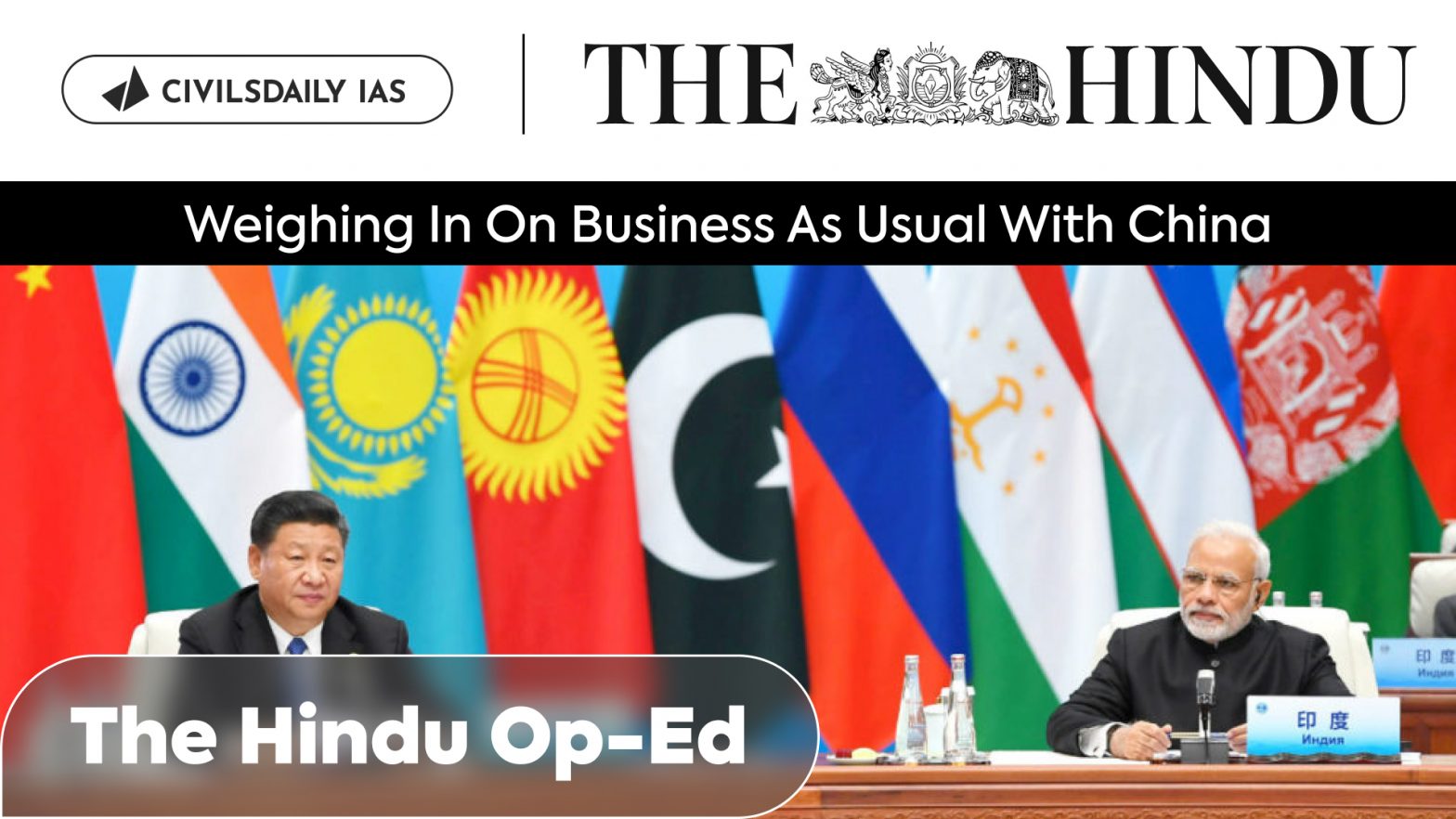| PYQ Relevance: Q) “The USA is facing an existential threat in the form of China, that is much more challenging than the erstwhile Soviet Union.” Explain. (UPSC CSE 2021) Q) Quadrilateral Security Dialogue (Quad) is transforming itself into a trade bloc from a military alliance, in present times Discuss. (UPSC CSE 2020) Q) The China-Pakistan Economic Corridor (CPEC) is viewed as a cardinal subset of China’s larger ‘One Belt One Road’ initiative. Give a brief description of CPEC and enumerate the reasons why India has distanced itself from the same. (UPSC CSE 2018) |
Mentor’s Comment: The Galwan Valley clash in June 2020 marked a significant deterioration in India-China relations, leading to profound shifts in the geopolitical and strategic calculus of both nations. The confrontation, which resulted in the deaths of 20 Indian soldiers and at least 4 Chinese soldiers, was the deadliest since the 1962 India-China war.
The future of economic cooperation between India and China will largely depend on how both nations navigate their geopolitical tensions and mutual dependencies. While there are opportunities for collaboration through investment and trade, significant barriers remain due to unresolved border disputes and India’s strategic shift towards self-reliance. As both countries reassess their positions in a rapidly changing global landscape, their economic relationship will likely continue to be characterized by cautious engagement rather than robust cooperation.
_
Let’s learn!
Why in the News?
On September 12, Indian External Affairs Minister S. Jaishankar noted that approximately 75% of disengagement issues along the border have been resolved, yet emphasized the ongoing challenge of militarization at the border.
- Further, during the BRICS NSA meeting in St. Petersburg, both sides agreed to expedite efforts for complete disengagement in the remaining areas.
What are the implications of China’s border policies on India-China relations?
- Escalation of Tensions: China’s aggressive border policies, particularly since the 2020 Galwan Valley clash, have led to heightened militarization along the Line of Actual Control (LAC), creating an environment of distrust and hostility between the two nations.
- Strategic Reassessment: The violent confrontations have prompted India to reassess its approach towards China, moving from a stance of cautious engagement to one of strategic vigilance and preparedness for potential conflict. This includes a call for greater military readiness and strengthening alliances, such as with the Quad.
- Impact on Bilateral Relations: Chinese attempts to compartmentalize the border dispute from broader bilateral ties are increasingly seen as untenable by India.
- The Indian government insists that progress in overall relations is contingent upon resolving border issues.
- Domestic Sentiment and Policy Changes: The public’s perception of China has deteriorated sharply following military confrontations, leading to calls for boycotting Chinese products and a general hardening of attitudes towards Beijing.
- This shift in sentiment is influencing India’s foreign policy, pushing for a more adversarial stance.
- Geopolitical Dynamics: China’s assertive policies in South Asia, including its close ties with Pakistan and investment initiatives through the Belt and Road Initiative (BRI), have intensified competition with India for regional influence.
- This rivalry complicates diplomatic efforts and fosters a security dilemma.
| What role does the QUAD play in India’s new military strategy? • Counterbalancing China: The Quad is a platform for India to collaborate with the United States, Japan, and Australia to counter China’s assertiveness in the Indo-Pacific. This alignment helps India enhance its military capabilities and strategic posture against potential threats from China. • Enhanced Defense Cooperation: Quad Group has facilitated joint military exercises, like Malabar naval exercises, which strengthen interoperability, enhancing India’s naval capabilities and readiness to respond to regional threats.Participation in the Quad allows India to extend beyond military cooperation to global challenges such as climate change and public health. • Capacity Building and Strategic Autonomy: India leverages the Quad to build its defense capabilities through technology sharing and joint initiatives focused on maritime security, cyber defense, and humanitarian assistance.India seeks to maintain its strategic autonomy by not fully aligning itself with U.S. This approach allows India to navigate its complex relationships with both China and other regional players without compromising its interests. • Economic Opportunities: The Quad enhances India’s attractiveness as an investment destination, particularly post-COVID-19, by promoting economic cooperation among member states. For Example, vaccine distribution highlights India’s role as a leader in regional health security. |
How should India respond to China’s demands for normalization of relations?
- Conditional Normalization: India should continue to insist on restoring the status quo ante along the Line of Actual Control (LAC) as a prerequisite for any significant diplomatic engagement with China.
- Diplomatic Engagement: India should engage in diplomatic discussions with China at various levels, including military-to-military talks and high-level political exchanges, to address mutual concerns and build confidence.
- Balanced Approach to FDI: While maintaining security concerns, India could selectively ease restrictions on Chinese Foreign Direct Investment (FDI) that align with its economic interests. This approach could facilitate economic ties while ensuring that strategic sectors remain protected.
- Strengthening Alliances: India should enhance collective security through QUAD and counterbalance China’s regional influence. This multilateral approach can give India greater leverage in its dealings with China.
What is the future of economic cooperation given the current geopolitical climate? (Way Forward)
- The future of economic cooperation will largely depend on how both nations navigate their geopolitical tensions and mutual dependencies.
- The “China plus one” strategy presents significant opportunities for India’s economic growth, particularly as global companies seek to diversify their supply chains away from China.
- According to a Nomura report, India’s exports could nearly double from $431 billion in 2023 to $835 billion by 2030, driven by demand from firms relocating to India as they seek alternatives to China.
While there are opportunities for collaboration through investment and trade, significant barriers remain due to unresolved border disputes and India’s strategic shift towards self-reliance.

